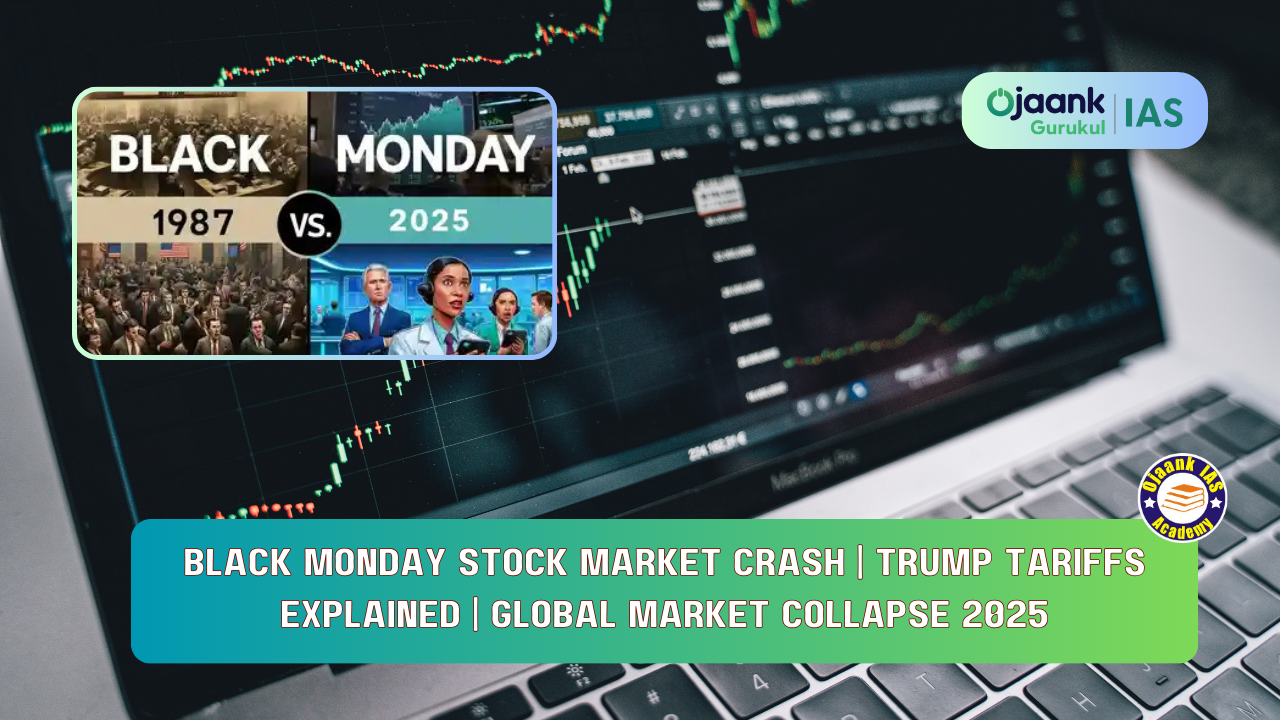Black Monday Stock Market Crash | Trump Tariffs Explained | Global Market Collapse 2025

Introduction: A Perfect Storm of Policy and Panic
Black Monday 2025 is no longer a hypothetical—it’s unfolding in real time.
After a brutal Sunday that saw Dow Jones and S&P Futures nosedive, Monday morning turned catastrophic across Asia and beyond. Japan’s Nikkei 225 tumbled nearly 9%, triggering circuit breakers and halting futures trading. The Hang Seng Index dropped 8%, and Indian markets mirrored the panic with a 5% plunge.
At the heart of this global bloodbath? US President Donald Trump’s aggressive reimplementation of reciprocal tariffs—a move that’s causing shockwaves from Tokyo to New York.
While critics once dismissed his tariff rhetoric as political posturing, this time, he’s not bluffing—and the world is reeling.
Tariffs: Simple Formula, Complex Fallout
The logic behind Trump’s tariff policy appears disarmingly simple:
T = (Trade Surplus of Partner / Trade Deficit of US) × Base Tariff Rate
But trade isn’t math—it’s politics, logistics, and strategy. The formula, allegedly akin to what AI like ChatGPT might suggest, attempts to balance trade deficits linearly. The Trump administration's real-world application? Far messier and much more dangerous.
-
Differential tariffs are slapped unevenly across trade partners.
-
Rules of origin loopholes are ripe for exploitation (e.g., Germany routing goods via the UK).
-
Trade war fatigue is already setting in.
What’s the Endgame? Four Plausible Scenarios
1. Trump Folds Under Pressure
A collapsing stock market and internal GOP backlash might force a policy reversal. The American public won’t tolerate inflation and job losses forever.
2. Tactical Pullback After Small Victories
If countries like Vietnam or Cambodia offer minor concessions, Trump might declare symbolic victory and ease tensions.
3. Congress Intervenes
Expect legislative moves to claw back tariff authority from the President, especially if legal challenges citing misuse of emergency powers gain traction.
4. Global Retaliation Escalates
China has already reacted strongly. The EU might target US digital services, launching a new front in the trade war that could hit Silicon Valley giants like Meta and Google.
Collateral Damage: From Lesotho to Taiwan
The tariff hit list is baffling:
-
Lesotho, a tiny African nation with $2.4B GDP, faces a 50% tariff—the highest of all—despite having no real trade friction.
-
Taiwan, America’s key chip supplier and democratic ally, is penalized even as it counters Chinese aggression.
-
Meanwhile, Russia and North Korea are oddly exempt.
This scattergun approach dilutes any rational objective and invites geopolitical confusion.
Domestic Blowback: Inflation, Deficits & Dollar Risk
Higher tariffs are fueling inflation—and not the good kind.
-
Consumers pay more, businesses struggle to maintain margins.
-
The Federal Reserve’s rate cut plan is now under threat.
-
Foreign creditors are reassessing faith in the dollar, jeopardizing America’s privilege of holding the global reserve currency.
The parallels to 2022’s freezing of Russian assets are hard to ignore. Central banks are already hoarding physical gold, signaling waning confidence in paper-based American supremacy.
Data Speaks: Tariff Effectiveness is a Myth
A study by MIT, Harvard, Zurich University, and the World Bank concluded that Trump's previous tariffs:
-
Had no net effect on US employment.
-
Induced negative impacts on American farmers due to retaliatory tariffs.
-
Required government subsidies to mitigate losses—funded ironically by tariff revenues.
In essence, the American taxpayer foots the bill for a policy that achieves little economically, and damages global relations.
A Digital Cold War on the Horizon?
With Brussels considering tariffs on American digital services, the next battleground isn’t just steel or soybeans—it’s tech.
-
EU regulators already scrutinize Apple, Meta, and Alphabet.
-
Retaliation here could cripple the companies that drove the US stock market bull run in the last year.
This escalation could drag innovators into political quicksand, and choke the very sectors that power the US economy.
Conclusion: Tariffs as the Trigger for a Global Reset?
Trump’s tariff gamble has already triggered a global financial shock, but its real consequences are still unfolding.
The world may be witnessing:
-
A fundamental shift in global trade order.
-
The weakening of the US dollar’s hegemony.
-
A rising tide of protectionism masked as patriotism.
-
And potentially, a new digital trade war.
Whether Trump’s strategy leads to short-term “wins” or long-term losses, the ripple effects are too vast to ignore. Black Monday 2025 might just become the starting point of a new economic Cold War.
Key Takeaways:
-
Global markets are in turmoil, triggered by Trump’s revived tariff regime.
-
The policy’s oversimplified logic is clashing with complex global trade realities.
-
Retaliatory moves, especially from China and the EU, could cripple American tech and services.
-
Domestic backlash is mounting, and the dollar’s dominance could erode if confidence in US policy wanes.
-
This could mark a historic shift in global economic power.